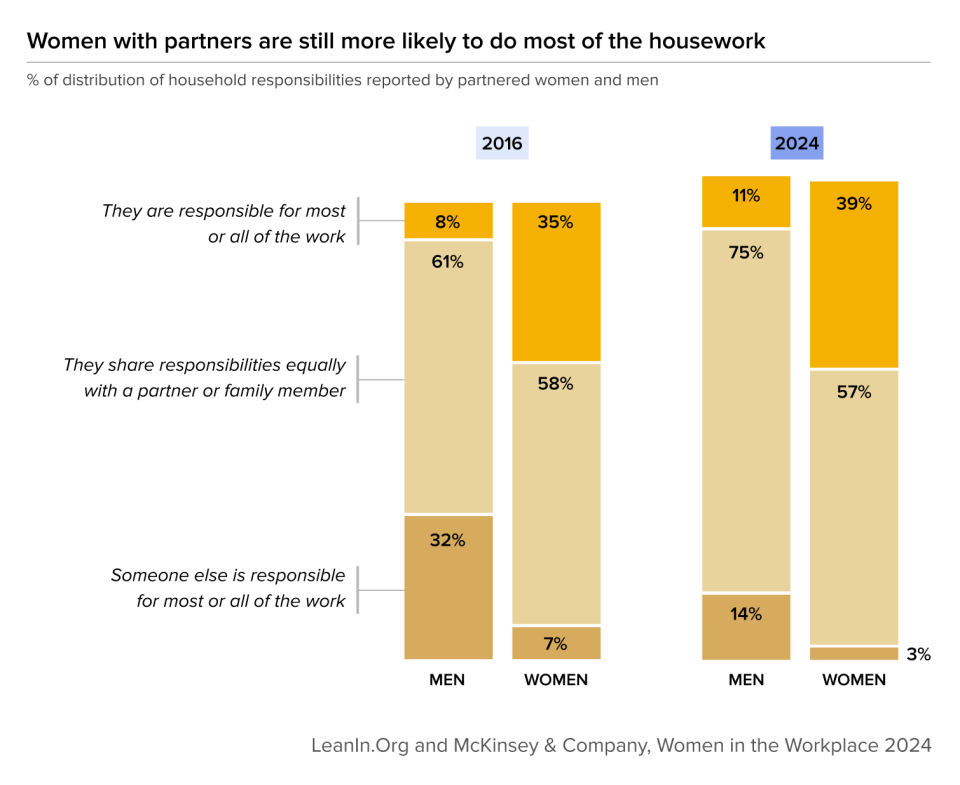Working women still do most of the housework—so why are men saying they now do a lot more?

When Namita Eveloy’s children were young in the early 2000s, her husband’s job as a software engineer became the priority. A leadership development consultant, Eveloy started choosing positions that she was overqualified for, or didn’t challenge her. She needed to log off at 3:00 p.m. most days to take care of the kids.
Now that Eveloy’s children are teenagers, she is able to focus on her career—and this shows in her advancement: She is now a senior leader at a nonprofit based in Brooklyn Park, Minneapolis.
But while her responsibilities have grown at work, an aspect of her home life has stayed the same: She is still primarily in charge of taking care of the kids and other domestic duties like meal planning and organizing the laundry service—and she thinks about all of these tasks more than her husband, too.
“We have a woman running for president and more women in leadership positions, yet we still have millions of working women who need more support to excel in their career aspirations,” says Eveloy. “In a society where we talk about the mental load and unequal share of parenting duties much more often, women are still responsible for most of the household duties.”

The gender gap in household duties continues to grow
Women hold far more power across corporate America than ever before: 29% of the C-suite is composed of women today, up from 17% in 2015. But Eveloy is part of a persistent group of working women who still do more housework, according to the latest findings from Lean In and McKinsey & Company’s annual Women in the Workplace report.
Today, roughly 4 in 10 women with partners say they are responsible for most or all of the housework—the same as in 2016. In contrast, over the same period of time, far more men report they share housework equally with their partner.
These diverging perceptions are concerning: They point to a growing gap in how women and men see their contributions at home.

“The majority, if not all, of the childcare falls to me. School drop-off and pick-up, getting dinner ready, doing bath time, story time, all of it,” says a Latina senior manager working as a government contractor who was interviewed alongside more than two dozen other employees from companies Lean In surveyed for the report. “But in moments when my partner is not working like crazy, he definitely tries to split things with me as much as possible.”
Cognitive versus physical labor
For experts who have studied this issue over time, Lean In and McKinsey’s findings are not all that surprising: Men tend to overreport what they are doing at home, while women underreport, says Eve Rodsky, the founder of Fair Play Institute, a private operating foundation aiming to advance equity with a focus on care justice.
Recently, Rodsky co-authored a study conducted at the University of Southern California that looked at how mothers and their partners divide up 30 common household tasks, such as laundry, groceries and helping with homework. The study differentiated between cognitive, or planning, aspects of a certain task and the physical labor, or execution, aspects. For example, when it comes to the task of groceries, the study differentiates between checking the fridge for what is low and making a list (the planning), versus shopping at the store and bringing the groceries back in the house (the execution).
The findings of the report support one theory that relates to Lean In and McKinsey’s findings: Mothers take on greater responsibility than their partners for the cognitive labor of 29 out of 30 tasks as well as the physical household labor for 28 out of 30 tasks.
Taking out the garbage was the only task for which partners were responsible for both the cognitive and physical labor.
“The entire world is focused on execution, and men are stepping up, but women are still doing most of the cognitive labor,” says Rodsky. “It is not men’s fault, but they have an inaccurate perception of what a task involves, so they are overreporting what they do.”
‘Taking ownership of all of it’
Keith Conti—a San Diego-based director of development who works with nonprofits—has been married to his wife Nicole, a change management consultant, for over 20 years. When his now 17-, 13-, and 11-year-old daughters were younger and his wife was taking a career break, it was clear she was doing more at home. But now, as Keith embarks on a career transition of his own, he finds himself stepping up around the house.
Regardless of what stage either of the Conti parents are in their careers, Nicole says Keith is a dad who is fully invested emotionally in his girls’ lives: while they were growing up, he was largely responsible for getting them ready in the morning, as well as dropping them off and picking them up from school.
“The core to the family thriving has been remaining flexible to what is needed in that moment, and both of us taking ownership of all of it,” says Nicole.
Yet Keith has a different understanding of what his wife takes on at home versus what he is responsible for.
“I make sure dishes are done and the laundry is clean, but those are just tasks,” says Keith. “When it comes to what is real, and has ramifications on my girls’ lives, my wife definitely does the heavy lifting there.”

‘I’m certain he doesn’t know how much goes through my head every day’
Lean In’s report also found that regardless of how high they climb on the corporate ladder, women continue to do more at home: Senior-level women with partners are over four times more likely than men in the same situation to do more housework.
Natasha Barncastle is an executive vice president of operations working from home for a wellness company out of Charlotte, North Carolina. With a husband who works on-site as a general contractor, Barncastle finds that her remote-work position means she takes on more of the responsibilities around the house.
And with four children—ages six, eight, nine, and ten years—living under her roof, there tends to be a lot of work to do outside of her corporate position.
“I think he is aware that I do a lot more than he does, but I am also 100%certain he doesn’t know how much goes through my head every day,” says 47-year-old Barncastle of her husband of 12 years. “There is no way I can even find a way to put into words all that is on my checklist and everything that needs to get done. That is just true for a lot of working moms.”

‘A swinging pendulum’
Unfortunately, there is no indication in the data that this trend is changing for the next generation of women coming up through the ranks in the workplace. Women under 30 with partners reported doing the same amount of housework as partnered women 50 and over.
And yet, there are signs younger partnered couples are having more conversations about how to make tasks at home more equitable. Thirty-one-year-old Nicole Gartside Jenkins, a product marketer working out of Austin, Texas, says she often talks with her husband—a sales manager for a tech company— about everything that needs to be done to care for their 2-year-old son outside of work.
Jenkins even owns the “Fair Play” cards, a tool created by Rodsky’s foundation to encourage couples to have an open dialogue about all the invisible tasks it takes to run a home. In part due to reading these cards, Jenkins and her husband implemented a system at home based on “total task delegation.”
Simply put, whether the task is organizing the childcare or doing the dishes, Jenkins and her husband attempt to make sure one person is responsible for all of it—from planning to execution. This has worked to some extent, but she’s finding that even bringing this level of intentionality to the topic has its limits.
“I have driven myself crazy thinking that it has to be 50-50, but it’s never going to be 50-,” says Jenkins. “It is going to be a swinging pendulum.”

 Yahoo Lifestyle
Yahoo Lifestyle 
